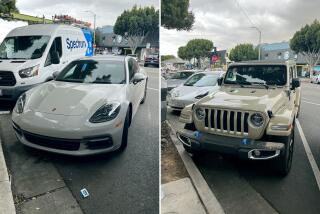Future’s look borrows from past
- Share via
DETROIT — Car shows are geared to appeal to the motor-heads among us: The wildest concept models and biggest engines get all the attention. And there was plenty of that at the North American International Auto Show this year.
But a walk through Motown’s capacious Cobo Hall with an eye on the vehicles in the shadows, just out of the spotlight, revealed telltale cues about what tomorrow’s cars and trucks will look like -- inside and out -- and the features they will offer to attract buyers in an increasingly competitive market.
“You didn’t come away with the feeling that something phenomenal had just occurred,” said David O’Connell, chief designer at Mitsubishi Motors Corp.’s U.S. research and design center in Cypress.
Still, the Detroit show, which ended Sunday, demonstrated “a lot of little sparks of energy that showed some trends,” O’Connell said.
One is the return of fender vents, or gills. They originated as hot air vents and openings for exposed exhaust pipes in a number of early automobiles and were popularized in the late 1940s by General Motors Corp., which used “ventiports,” or portholes, arranged along the side of the car just ahead of the front doors, in its Buick vehicles.
Land Rover updated the look recently with long vertical slits just behind the front wheel well of its Range Rover models.
Others followed, including GM’s Cadillac, which joined the crowd with chromed vent openings high on the front fenders of the Escalade sport utility vehicle.
At the Detroit show, at least a dozen models on display -- concepts as well as production models heading to dealer showrooms -- featured rectangular or slotted vents and ventlike trim pieces of one sort or another.
“Everybody’s doing gills,” said market researcher George Peterson, president of AutoPacific Inc. in Tustin.
Some were functional, such as slots that enable hot air to flow out from under the hood of the Jaguar C-XF four-door sedan concept. Others, notably the chromed faux vents slapped onto the side of Ford Motor Co.’s 2008 Focus, had little function beyond an attempt at eye appeal.
The big news for exterior design, though, seems to be that the featureless curves of the jellybean shape popular for most of the last 20 years -- think Ford Taurus -- have finally been melded with the angles and creases of the origami school of design that defined cars of the 1970s.
The result is that cars and trucks are starting to sport surfaces with tauter curves highlighted by muscular flared fenders and bold character lines -- the ridges or creases that run from front to back along the side of a vehicle, usually beneath or just above the level of the door handles.
“Car shapes won’t be looking so melted,” Mitsubishi’s O’Connell said.
Perhaps the best example was the Accord coupe concept car shown by Honda Motor Co.
Company insiders describe the model as close to what the production car will be when it is launched in the fall.
The concept on display in Detroit featured a long hood, a sloping rear window line reminiscent of a 1966 Ford Mustang fastback and an aggressive nose-down, rear-in-the-air stance highlighted by bulging rear fender flares.
“The era of the bland mid-sized car for everyman is going away,” analyst Jim Sanfilippo said. Automakers have “finally figured out that no customer wants a boring car.”
The Honda was a coupe, but Sanfilippo, of Detroit-based auto marketing and product research firm AMCI, said he expected the next-generation Accord sedan to share some of the same lines.
Interior styling trends were also a hot topic in Detroit.
“That was the general direction of the show, better interiors,” said Steve Lewis, assistant chief designer at Audi’s U.S. advanced design studio in Santa Monica.
Automakers have rediscovered “that while people initially are attracted by the exterior, the interior has to captivate because that’s where we spend most of our time” after buying the car, he said.
Cheap, hard, shiny plastic surfaces have become a thing of the past as even the least-expensive economy cars have begun to offer upgraded interiors with soft, textured vinyls, nubby cloth upholstery and metallic accent pieces.
“Everyone has gone upscale,” said Hak Soo Ha, a design manager for the interior design group at Dearborn, Mich.-based Ford.
Most automakers will soon be offering some kind of electronic interface in their vehicles to enable drivers and passengers to plug their digital music players, wireless cellphones and even laptop computers into onboard audio systems.
“The show was all about how cars can be individualized, how the vehicle now is going to be all about the consumer,” said Jack Jittkaroonrus, a designer at CarLab, an automotive product development firm in Orange.
Color too is making a comeback.
“Silver’s been the popular hot color, but this year we saw a lot of blues, purples and oranges” on concept and production cars, said Susan Lampinen, chief of Ford’s color and materials design group in Dearborn.
Several manufacturers set off basic black cloth and leather interiors with contrasting stitching.
Even Detroit-based GM -- not noted for high-end interiors in the past -- wowed many at the show with the interiors of two redesigned 2008 models, the Cadillac CTS and Chevrolet Malibu mid-size sedans.
The Chevy featured luxurious rust-colored leather seat surfaces and carried the rust-and-black theme to the dashboard and door panels as well.
“The Malibu, inside and out, was good enough to take us back to the hallmark of Chevy design in 1955-57,” said AutoPacific’s Peterson, a former Ford executive. “This is one that can show the industry how to recapture some of the passion.”
*





